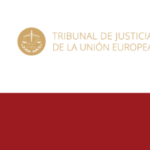In 2016, Ms Santa Conte filed an application with the European Union Intellectual Property Office (EUIPO) for registration of the following figurative sign as an EU trade mark, in respect of food and drink items and catering services:
EUIPO rejected her application, finding that the sign was contrary to public policy. Ms Conte therefore brought an action before the General Court seeking annulment of EUIPO’s decision.
The Court dismisses the action, with the result that EUIPO’s decision is upheld.
The Court finds that EUIPO was fully entitled to consider that the stylised depiction of a cannabis leaf is the media symbol for marijuana and that the word ‘amsterdam’ refers to the fact that the city of Amsterdam has points of sale for that narcotic derived from cannabis, due to the sale of cannabis being tolerated, under certain conditions, in the Netherlands. Furthermore, the inclusion of the word ‘store’, which normally means ‘shop’, means that the public could expect the goods and services sold under that sign to correspond to those which would be available in a shop selling narcotic substances. Thus, the Court, whilst acknowledging that hemp is not regarded as a narcotic substance below a certain tetrahydrocannabinol (THC) threshold, concludes, in this case, that it is due to the combination of those different elements that the sign at issue draws the attention of consumers, who do not necessarily have accurate scientific or technical knowledge regarding cannabis as a narcotic substance which is illegal in many EU countries.
Public Policy
As regards the concept of ‘public policy’, the Court states that, even if, currently, the issue of the legalisation of cannabis for therapeutic and even recreational purposes is under discussion in many Member States, as the law currently stands, the consumption and use of cannabis above the stated threshold remain illegal in most of those States. Thus, in those States, tackling the spread of the narcotic substance derived from cannabis meets a public health objective aimed at combating the harmful effects of that substance. The rules applicable to the consumption and use of that substance are therefore a matter of ‘public policy’.
The Court emphasises that, since one of the functions of a trade mark consists of identifying the commercial origin of the goods or services, thus enabling the consumer to make his or her choices, the sign at issue, in so far as it will be perceived as described above, encourages, implicitly but necessarily, the purchase of such goods and services or, at the very least, trivialises their consumption.







Leave a Reply